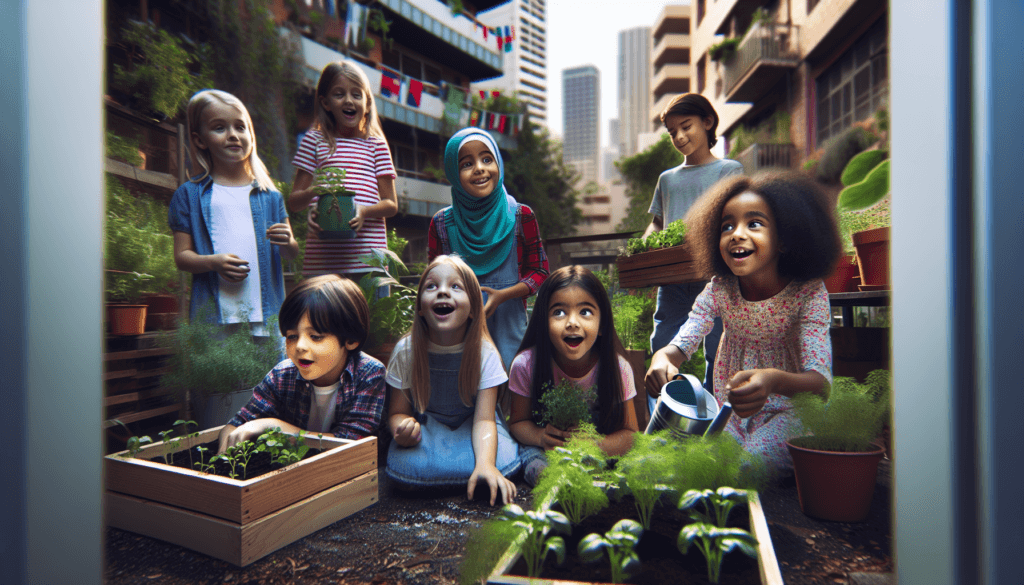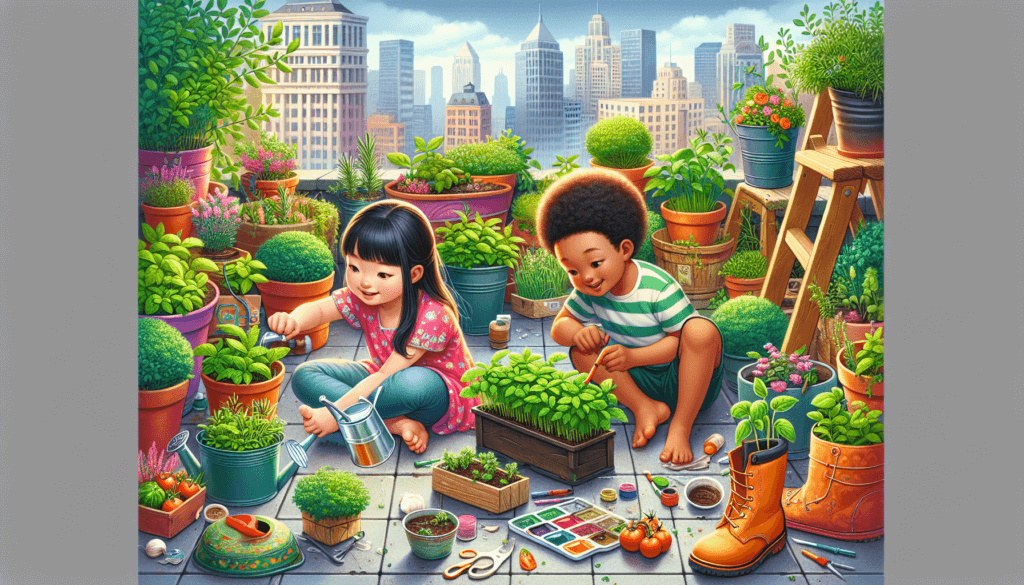In this article, you will discover a delightful compilation of urban gardening ideas specially crafted for kids. These fun and educational projects will not only engage your little ones but also teach them about the wonders of nature and the importance of sustainability. From growing their own herbs in a windowsill garden to creating mini vertical gardens, this article will inspire you with creative ways to bring the joy of gardening into your urban setting. Get ready to embark on a green adventure with your kids and watch as their curiosity and love for plants flourish!

Container Gardening
Choose the Right Container
Container gardening is a great way to start your gardening journey, especially if you have limited outdoor space. The first step is to choose the right container. Look for containers that have drainage holes to prevent waterlogging. Plastic, ceramic, and wooden containers are all suitable options. Consider the size of the container as well – it should be large enough to accommodate the plant’s root system, but not too big to overwhelm the plant.
Select Suitable Plants
Once you have your containers ready, it’s time to select suitable plants for your urban garden. Herbs like basil, mint, and rosemary thrive in containers and can be used in various culinary dishes. If you’re more interested in flowers, petunias, pansies, and marigolds are popular choices for container gardens. Make sure to choose plants that are well-suited to your climate and the amount of sunlight your space receives.
Create a Mini Herb Garden
A mini herb garden is a fantastic addition to any urban gardening project. Not only do herbs provide fresh ingredients for your culinary adventures, but they also add fragrance and beauty to your space. Plant a variety of herbs such as parsley, cilantro, and thyme in individual containers. Make sure to label each container, so you know which herb is which. You’ll be able to enjoy the rewards of your herb garden in no time!
Design a Colorful Flower Pot
Bright and colorful flower pots can liven up any urban garden space. Choose a variety of flowers in different colors and sizes to create an eye-catching display. Fill your flower pots with vibrant marigolds, petunias, or pansies. You can arrange the flowers in a single color scheme or mix and match for a more eclectic look. Place the flower pots strategically around your garden to create a visually appealing focal point.
Make a Succulent Terrarium
Succulents are low-maintenance plants that are perfect for urban gardeners. Create a unique and decorative succulent terrarium by gathering small succulent plants and arranging them in a glass container. Layer the bottom of the container with rocks or pebbles for drainage and add a layer of potting soil on top. Plant the succulents in the soil and surround them with decorative elements like colored sand or small decorative stones. Your succulent terrarium will be both beautiful and easy to care for.
Vertical Gardening
Construct a Vertical Planter
Vertical gardening is an innovative way to maximize limited space in an urban garden. Constructing a vertical planter allows you to grow plants vertically, saving valuable ground space. Use materials like wooden pallets or PVC pipes to create a sturdy structure. Hang planters or attach containers to the structure, ensuring that each container has proper drainage. Fill the containers with your desired plants and watch them grow vertically, creating a stunning visual display.
Grow a Vertical Salad Garden
If you’re a fan of fresh salads, why not grow your own ingredients in a vertical salad garden? Lettuce, spinach, and herbs like basil and parsley are excellent choices for a vertical salad garden. Hang a sturdy wire mesh or a series of small individual containers on a wall or fence. Plant the seedlings in the containers, ensuring they have enough space to grow. Regularly water and fertilize the plants, and you’ll have delicious and nutritious salad ingredients at your fingertips.
Create a Hanging Herb Garden
For those who love herbs and want to save space, a hanging herb garden is the way to go. Choose a sunny spot and hang small pots or containers from a pergola, fence, or balcony railing. Plant herbs such as thyme, oregano, and sage, ensuring they are well-watered and receive enough sunlight. Having your herbs within easy reach makes cooking a breeze, and the aromatic scents add a wonderful ambiance to your urban garden.
Build a Flower Wall
A flower wall is an eye-catching addition to any urban garden. Utilize a fence, trellis, or even a pallet as the base for your flower wall. Choose an array of colorful flowers that thrive in vertical growing conditions, such as morning glories, clematis, or sweet peas. Plant the flowers at the base of the wall and gently guide them to grow upwards using hooks or twine. As the flowers bloom, your flower wall will become a stunning focal point that adds beauty and charm to your space.
Make a Vertical Fairy Garden
Get your kids involved in gardening by creating a vertical fairy garden. Use a wooden dowel or a piece of rebar as the central structure and attach small containers or pots to it. Fill the containers with soil and choose small plants like succulents, moss, and miniature flowers. Add small decorative elements such as mini fairy houses, tiny benches, and fairy figurines to create a whimsical atmosphere. Your kids will love watching their vertical fairy garden come to life.
Indoor Gardening
Start a Windowsill Garden
Indoor gardening is an excellent option for those with limited outdoor space or during the colder months. Utilize your windowsills by planting herbs, small flowers, or even vegetables in containers. Make sure the containers have proper drainage and place them in a sunny spot. Regularly water and fertilize the plants, and you’ll have a beautiful indoor garden that adds freshness and greenery to your home.
Plant a Kitchen Herb Garden
Having fresh herbs readily available in your kitchen can elevate your cooking to new heights. Plant a kitchen herb garden in small pots or containers on your countertop or a designated area in your kitchen. Choose herbs that you commonly use in your cooking, such as basil, thyme, and parsley. Make sure to water them regularly and enjoy the convenience of having fresh herbs at your fingertips whenever you need them.
Create a Miniature Greenhouse
If you’re interested in experimenting with different plants and seeds, creating a miniature greenhouse can be an exciting project. Use clear plastic containers or repurpose old aquariums and place them near a sunny window. Fill the containers with potting soil and plant seeds or seedlings of your choice. The enclosed environment of the greenhouse will create optimal conditions for plant growth, and you’ll be able to witness the magic of germination firsthand.
Try Hydroponics
Hydroponics is a fascinating gardening technique that involves growing plants without soil. Instead, plants receive their nutrients from a water-based solution. This method is perfect for space-saving gardening as it doesn’t require soil. Purchase a hydroponic system or create your own using containers, a water pump, and nutrient-rich solution. Choose plants like lettuce, herbs, or even cherry tomatoes, and watch them thrive in their hydroponic environment.
Set up a Terrarium
Terrariums are self-contained mini ecosystems that add a touch of nature to your indoor space. Select a glass container, such as a jar or vase, and layer it with small stones for drainage. Add a layer of activated charcoal to prevent mold and mildew, and then fill it with potting soil. Choose small plants such as moss, ferns, or succulents and arrange them creatively in the container. Terrariums require minimal maintenance and can be a beautiful focal point indoors.
DIY Garden Crafts
Decorate Plant Pots
Personalize your garden by decorating plant pots with your unique artistic style. Purchase plain terracotta pots and use waterproof paints, markers, or even decoupage techniques to add color and patterns. Let your creativity shine by painting flowers, geometric designs, or even writing inspirational quotes. Alternatively, you can repurpose old containers such as tin cans or mason jars and give them a new life with a fresh coat of paint and decorative elements.
Make Seed Bombs
Seed bombs are a fun and creative way to spread flowers and plants throughout your urban garden or beyond. Mix together clay, soil, and a selection of flower or herb seeds. Roll small portions of the mixture into balls and let them dry. Once the seed bombs are dry, they can be thrown or planted in suitable areas. Whether you want to add more flowers to your garden or beautify neglected spaces in your community, seed bombs are a playful and eco-friendly solution.
Create Garden Markers
Keep your garden organized and visually appealing by creating your own garden markers. Gather small rocks, pebbles, or wooden craft sticks. Use waterproof markers or paints to write the names of the plants or draw small images that represent each plant. Place the markers next to your plants, ensuring they are easily visible. Not only will these markers help you identify your plants, but they can also add a decorative touch to your garden.
Design a Butterfly Feeder
Invite butterflies into your urban garden by designing a butterfly feeder. Start by cutting a small sponge into a rectangular shape and soaking it in a mixture of sugar water. Attach a string or a wire to one end of the sponge and hang it from a tree branch or attach it to a stake. Butterflies will be attracted to the sweet scent, and you’ll be able to observe these beautiful creatures up close.
Craft a Garden Wind Chime
Add a whimsical touch to your garden with a homemade wind chime. Collect small objects such as seashells, metal or wooden pieces, and colorful beads. Attach these items to a sturdy string or wire, ensuring that they hang at different heights. Hang the wind chime from a tree branch or a pergola, and let the gentle breeze create soothing sounds as it passes through your garden.

Gardening Games and Activities
Plant Identification Game
Get your kids excited about plant identification by creating a fun and educational game. Take photos of different plants or draw pictures and print them out. Attach the images to popsicle sticks or small cards. Have your kids explore the garden and match each plant to its corresponding picture or description. This game not only helps children learn about different plants but also encourages observation skills and attention to detail.
Garden Scavenger Hunt
Organize a garden scavenger hunt to keep kids engaged and excited about gardening. Create a list of items or plants for them to find, such as a ladybug, a red flower, or a leaf with jagged edges. Provide them with a bag or a basket to collect their treasures. The scavenger hunt will not only allow them to explore the garden but also inspire their curiosity and appreciation for the beauty of nature.
Garden Memory Match
Test your memory skills with a garden-themed memory match game. Print out images of different plants, flowers, or garden tools and laminate them for durability. Shuffle the cards and place them face down in a grid formation. Turn over two cards at a time and try to match the pairs. This enjoyable game improves memory and concentration while teaching kids about different elements of gardening.
Nature Art with Pressed Flowers
Pressing flowers is a timeless craft that allows you to preserve the beauty of nature. Take your kids on a nature walk and collect flowers or leaves that catch their attention. Place the flowers or leaves between sheets of parchment paper and press them inside heavy books for a few weeks. Once the flowers are dry and flat, use them to create unique artworks. Arrange the pressed flowers on paper or create intricate designs by gluing them onto picture frames or glass jars.
Build a Bug Hotel
Promote biodiversity and create a habitat for beneficial insects with a bug hotel. Collect natural materials such as twigs, pinecones, and bamboo sticks. Arrange these materials inside a wooden box or create small bundles tied together with twine. Place the bug hotel in a secluded area of your garden. This DIY project not only encourages the presence of beneficial insects but also provides an opportunity for kids to learn about the importance of insects in our ecosystem.
Composting and Recycling
Start a Compost Bin
Composting is a great way to reduce waste and create nutrient-rich soil for your plants. Start a compost bin by collecting organic kitchen scraps such as fruit and vegetable peels, coffee grounds, and eggshells. Mix the kitchen waste with dry materials like leaves or shredded paper to achieve the right carbon-to-nitrogen ratio. Turn the compost regularly and keep it moist. Before you know it, you’ll have rich compost that will nourish your plants and help reduce your carbon footprint.
Make Compost Tea
Compost tea is a liquid fertilizer that can benefit your plants’ growth and overall health. To make compost tea, fill a bucket or container with water and add a generous amount of well-aged compost. Let the mixture steep for a few days, stirring occasionally. Strain the liquid and dilute it with water before using it to water your plants. Compost tea provides a concentrated boost of nutrients that can promote vigorous growth and ward off diseases.
Build a Wormery
Vermicomposting, or using worms to compost, is an efficient and space-saving way to reduce waste. Create a wormery by drilling holes in a large plastic container and adding bedding materials such as shredded newspaper or cardboard. Purchase composting worms, such as red wigglers, and introduce them to the wormery along with organic kitchen scraps. The worms will break down the waste and produce nutrient-rich worm castings, which can be used as a natural fertilizer for your plants.
Recycle and Repurpose
Gardening provides numerous opportunities to recycle and repurpose materials. Instead of throwing away plastic containers, repurpose them as plant pots. Use old egg cartons as seed starting trays. Get creative and repurpose items like wooden pallets as raised beds or tin cans as garden markers. By repurposing materials, you not only reduce waste but also give new life to objects that would have otherwise been discarded.
Create a Garden from Recycled Materials
Take recycling to the next level by creating an entire garden using recycled materials. Use discarded tires as raised beds, stack old pallets to create vertical gardens, or repurpose old wooden crates as planters. Consider using plastic bottles to create self-watering containers or repurposing a broken wheelbarrow as a unique garden feature. The possibilities are endless, and by using recycled materials, you’re not only reducing waste but also adding a touch of creativity to your urban garden.

Butterfly and Bee Gardens
Research Butterfly and Bee Species
Before creating a butterfly and bee garden, it’s important to research the specific butterfly and bee species that are native to your area. Different species have different habitat requirements and preferences for nectar plants. By understanding the needs of these pollinators, you can tailor your garden to attract and support them effectively.
Plant Host and Nectar Plants
Butterflies and bees have specific plants that they rely on for survival. Plant host plants that act as food sources for butterfly larvae, such as milkweed for monarch butterflies. Include a variety of nectar plants that produce flowers with different shapes, colors, and bloom times to attract a diverse range of butterflies and bees. Some popular nectar plants include lavender, coneflowers, and butterfly bushes.
Create a Butterfly Puddle
Butterflies require minerals and salts in their diet, which they often obtain from puddles. Create a butterfly puddle by filling a shallow container with damp sand, rocks, and water. Place the container in a sunny location near your butterfly garden. Butterflies will be attracted to the puddle, providing them with essential nutrients and giving you the opportunity to observe these beautiful creatures up close.
Build a Bee Watering Station
Bees need a water source just like butterflies. Create a bee watering station by filling a shallow dish or bird bath with fresh water. Add some floating objects like twigs or corks to provide a landing platform for the bees. Place the watering station in a sunny spot near your bee-friendly plants. The water will not only attract bees but also help them stay hydrated while they pollinate your garden.
Make a Butterfly Feeding Station
Provide a food source for butterflies by creating a butterfly feeding station. Mix together a solution of sugar and water, dissolving approximately one part sugar in four parts water. Soak a clean sponge or cotton ball in the solution and place it in a shallow dish or bottle cap. Butterflies will be attracted to the sweet scent and feed on the sugary solution. Remember to refresh the solution regularly to keep the feeding station inviting.
Culinary Garden
Grow Pizza Ingredients
What could be more fun for kids than growing the ingredients for their favorite food? Create a pizza garden by planting tomatoes, basil, oregano, and other toppings like bell peppers or onions. Provide support for the tomato plants with stakes or trellises. As the plants grow, you’ll have an abundant supply of fresh and flavorful ingredients to make homemade pizzas with your kids.
Plant a Salsa Garden
If your family enjoys Mexican cuisine, a salsa garden is a must-have. Plant tomatoes, peppers, onions, and cilantro for all the essential ingredients. Ensure the plants receive enough sunlight and nutrients to thrive. Once the vegetables are ready to harvest, gather your family to make homemade salsa and enjoy the fruits of your labor.
Create a Salad Bar Garden
Encourage a healthy lifestyle by creating your own salad bar garden. Plant a variety of lettuces, spinach, and other leafy greens. Add a selection of vegetables like cherry tomatoes, cucumbers, radishes, and carrots. Harvest the vegetables as they mature and enjoy fresh and nutritious salads throughout the growing season. This project is not only a fun way to involve kids in gardening but also promotes healthy eating habits.
Make Lemonade from Scratch
Grow your own lemons and make delicious lemonade from scratch. Purchase a lemon tree or start one from seeds. Choose a sunny spot in your garden or grow the tree in a large container indoors. Once the lemons are ripe, squeeze the juice into a pitcher, add water and sugar to taste, and enjoy refreshing homemade lemonade with your family.
Harvest and Cook Herbs
Teach kids about the joys of cooking by involving them in harvesting and using fresh herbs from the garden. Let them help you pick herbs like basil, parsley, or cilantro. Use the herbs as flavorings in various dishes, from pasta sauces to soups and marinades. Engaging in the whole process, from growing to cooking, will foster a sense of accomplishment and appreciation for homegrown ingredients.

Gardening Science Experiments
Study Seed Germination
Explore the wonders of plant life by studying seed germination. Take a variety of seeds and plant them in different conditions, such as soil, paper towels, or in the presence of different light levels. Observe and document the speed and success rate of germination under each condition. This experiment will help kids understand the importance of germination and the factors that contribute to successful plant growth.
Examine Plant Growth Factors
Investigate the factors that influence plant growth by conducting experiments on light, water, and fertilizer. Plant identical seeds in separate containers and expose them to different light conditions, varying amounts of water, or different types and quantities of fertilizer. Observe and record how each factor affects plant growth. This experiment will teach kids about the crucial role these factors play in the health and development of plants.
Research Pollination and Bees
Delve into the world of pollination by researching the vital role bees play in the process. Learn about the anatomy of a flower and how bees transfer pollen from one flower to another. Observe and document the flowers in your garden to identify the bees or other pollinators that visit them. This experiment will not only teach kids about the importance of pollination but also raise their awareness of the declining bee populations and the need for conservation efforts.
Test Soil Composition
Discover the composition of your garden soil by conducting a simple soil composition test. Collect soil samples from different areas of your garden and mix them with water. Allow the mixtures to settle, and observe the layers that form. This experiment will give kids insights into the different components of soil, such as sand, silt, and clay. They will also learn how varying soil compositions can affect plant growth.
Observe Photosynthesis
Observe the process of photosynthesis in action by conducting an experiment that demonstrates the importance of light to plants. Place a healthy potted plant in a dark room or cover it with a dark cloth. Observe the plant over a few days and compare it to a plant that is receiving adequate light. Kids will be able to witness the effects of light deprivation on a plant and gain a deeper understanding of the significance of sunlight in plant life.
Community Gardening
Join a Community Garden
Community gardens are a fantastic opportunity to connect with other gardeners in your community and share your gardening experiences. Joining a community garden allows you to learn from experienced gardeners, exchange ideas, and contribute to a larger gardening project. It’s a chance to become part of a supportive community that values the beauty and benefits of urban gardening.
Organize a School Garden
School gardens provide invaluable learning experiences for children. Organize a school garden project by collaborating with teachers, parents, and students. Select a suitable area within the school grounds and plan the layout of the garden. Involve children in planting and maintaining the garden, providing them with hands-on experience and giving them a sense of responsibility and pride. A school garden not only enhances the beauty of the campus but also teaches kids about the importance of nature and healthy food choices.
Participate in Seed Swaps
Seed swaps are a wonderful way to diversify your garden and exchange knowledge with other gardeners. Participate in local seed swap events or organize one in your community. Bring your extra seeds or surplus produce and trade them for different varieties of seeds or plants. Seed swaps foster a sense of community and create opportunities for gardeners to connect, share tips, and learn from one another.
Host Gardening Workshops
Share your love and knowledge of gardening by hosting gardening workshops in your community. Offer hands-on sessions where participants can learn about various gardening techniques, such as container gardening, vertical gardening, or composting. Provide information on selecting suitable plants for different conditions and give practical demonstrations. Gardening workshops not only educate and inspire others but also create a sense of empowerment and self-sufficiency.
Contribute to Public Green Spaces
Take your gardening skills beyond your own garden and contribute to public green spaces in your community. Volunteer to maintain local parks or community gardens. Offer your expertise in planting and maintaining flower beds or organizing communal gardening sessions. By contributing to public green spaces, you not only enhance the beauty of your community but also create a welcoming and inviting environment for everyone to enjoy.
In conclusion, urban gardening offers a wide range of fun and educational projects for kids. Whether it’s container gardening, vertical gardening, indoor gardening, DIY garden crafts, gardening games and activities, composting and recycling, butterfly and bee gardens, culinary gardens, gardening science experiments, or community gardening, there are endless opportunities to explore, learn, and enjoy the journey of nurturing plants and connecting with nature. So go ahead, grab a shovel, and let your urban gardening adventure begin!



